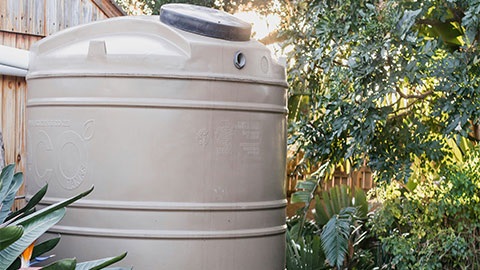Rainwater tanks

Rainwater tanks are for collecting, storing, and maintaining rainwater runoff, usually from rooftops.
Stored water can be for drinking, watering gardens, topping up pools, and supply water to fixtures.
Benefits of rainwater tanks
Benefits of rainwater tanks for individual households and the wider community include:
- reducing water bills as an alternative to the primary water supply use
- boosting household water supply during times of drought
- protecting local waterways
- reducing the amount of rainwater entering the stormwater system.
Protecting the water quality in rainwater tanks
To help avoid your rainwater tank water becoming contaminated, you can:
- Install a first flush device to prevent the collection of the first portion of roof run-off. This will reduce dust, bird droppings and leaves contaminating tank water.
- Use a fine mesh screen to prevent material from entering the tank.
- Inspect the tank for bottom sediments, and flush it to remove debris every 6 to 12 months.
- Prune or remove all overhead vegetation and debris from roofs and gutters every 3 to 6 months.
- Check for evidence of animal access to the tank every 6 months and repair and close any openings to the tank.
- Disinfect the tank by adding a suitable disinfectant. For example, 40 millilitres of liquid sodium hypochlorite per 1,000 litres of water.
As a precaution, avoid using pesticide-treated timbers and lead flashing in roof catchments. Also avoid collecting rainwater from parts of roofs incorporating flues from wood burners.
Building approval for a rainwater tank
Generally, building approval is not required for a new rainwater tank if it is:
- no more than 10 metres square in plan area
- less than 3.6 metres in diameter
- no higher than 2.4 metres including any supporting structure
- no longer than 5 metres on any side.
Tanks that cannot meet these requirements need building approval.
Rainwater tanks for all new buildings need building approval.
Setback and height requirements for rainwater tanks
A rainwater tank can be located within:
- 1.5 metres of the side and rear property boundaries provided the tank, including any support structure, is no higher than 2.4 metres above the natural ground surface
- 6 metres of any front road boundary, provided the tank, including any support structure, does not exceed 1 metre in height above natural ground surface.
If the rainwater tank does not meet the above criteria, it will need to be assessed by Council under the Queensland Building Code.
Find out more about placing a structure on your property.
Plumbing approval to install a rainwater tank
If connecting a rainwater tank to an existing building for indoor use or to service a hose tap, the plumber must register notifiable work. Indoor use may include laundry tubs and toilets. This is because they are plumbed to internal fixtures with a connection to the town water supply.
Generally, this is not required if a rainwater tank is for outdoor use only. For example, the rainwater tank is not connected to an internal fixture or pipework, and a pump has not been added to service a hose tap. This may include watering gardens with a hose from the outlet of the tank or for agricultural use.
Backflow prevention devices
Backflow prevention devices prevent the reverse flow of contaminants into a water supply.
Rainwater tanks do not usually need a backflow prevention device. A tank on a property within Unitywater’s area and connected to internal fixtures may need one.
Learn more about backflow prevention devices.
Overflow from rainwater tanks
The overflow from rainwater tanks me be piped to a suitable discharge point. This is so that it does not create a nuisance to neighbouring land, buildings and structures.
A discharge point could be an inter-allotment stormwater drainage system or the street kerb and channel. If this is not possible, pipe the overflow to a soakage pit. Locate the pit as far as practicable from buildings, structures, and property boundaries.
Building a rainwater tank near stormwater infrastructure
Building work over or near stormwater drains must be assessed. Find out more about placing a structure on your property.
This does not apply to self-assessable building work unless the structure is supported by a strip footing.
All applications to build over or next to a Unitywater sewer or water main are to be referred to Unitywater.
Rainwater tanks in areas serviced by town water
Allotments serviced with town water do not need a rainwater tank. Installing one is voluntary.
The installation must follow all relevant legislation. For more information, refer to the Queensland Development Code.
Rainwater tanks in rural areas not serviced by town water
There is no minimum tank capacity for houses on allotments that are not serviced with town water.
The installation must follow all relevant legislation. For more information, refer to the Queensland Development Code.
Water storage for firefighting and bushfire prone areas
Adequate water supply made available for firefighting is under the Planning Scheme. For more information refer to the Planning Scheme.